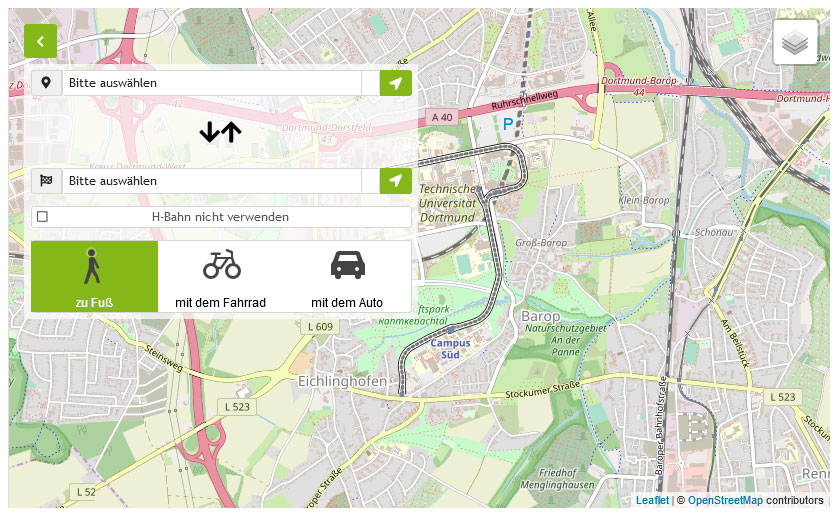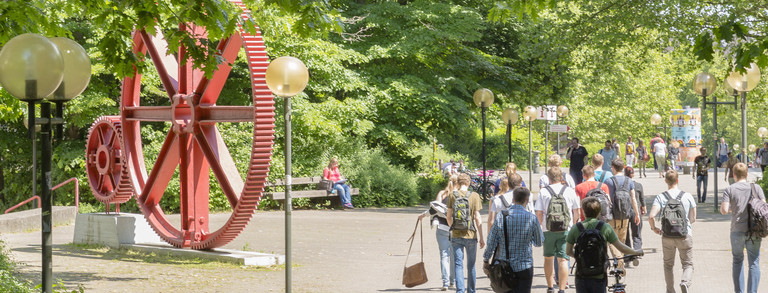Dr. Franziska Kappenberg
Contact
TU Dortmund University
Department of Statistics
Statistical Methods in Genetics and Chemometrics
Mathematics Building, Room 713
44221 Dortmund
Germany
E-Mail: kappenbergstatistik.tu-dortmundde
Phone: +49 231 755 5908

- Dr. rer. nat (Statistics): TU Dortmund University, 2021
Thesis: Statistical approaches for calculating alert concentrations from cytotoxicity and gene expression data - M.Sc. (Statistics): TU Dortmund University, 2018
Master thesis: Vorhersage von Lebertoxizität aus Genexpressionsdaten - B.Sc. (Mathematics): Rheinische Friedrich-Wilhelms-Universität Bonn, 2015
Bachelor thesis: Das Gesetz des iterierten Logarithmus für die Irrfahrt auf dem unendlichen Perkolationscluster
Scientific Work
- since April 2021: Postdoc at the Department of Statistics
- April 2018 - March 2021: Research Assistant and doctoral student at the Department of Statistics
- August 2017 - March 2017: Student research assistant at the Department of Statistics
- Analysis of gene expression data
- Statistical methods in toxicology
- Modeling of dose-response curves
- Classification and prediction of liver and neurotoxicity
Previous project work:
- Since 2021: DFG-funded research training group 2624 "Biostatistical Methods for High-Dimensional Data in Toxicology"
- 2020: BMBF project "SysDT"
- 2018-2020: BMBF project "LivSys Transfer"
2024
Ghallab, A., González Leiva, D. F., Strängberg, E., Hofmann, U., Myllys, M., Hassan, R., Hobloss, Z., Brackhagen, L., Begher-Tibbe, B., Duda, J. C., Drenda, C., Kappenberg, F., Reinders, J., Friebel, A., Vucur, M., Turajski, M., Seddek, A., Abbas, T., Abdelmageed, N., … Hengstler, J. G. (2024). Inhibition of the renal apical sodium dependent bile acid transporter prevents cholemic nephropathy in mice with obstructive cholestasis. Journal of Hepatology, 80(2), 268–281. https://doi.org/10.1016/j.jhep.2023.10.035
Kappenberg, F., Küthe, B., & Rahnenführer, J. (2024). MoS-TEC: A toxicogenomics database based on model selection for time-expression curves. Computational Toxicology [ISSN: 2468-1113], 30, 100313. https://doi.org/10.1016/j.comtox.2024.100313
2023
Almstedt, K., Krauthauser, L., Kappenberg, F., Wagner, D.-C., Heimes, A.-S., Battista, M. J., Anic, K., Krajnak, S., Lebrecht, A., Schwab, R., Brenner, W., Weikel, W., Rahnenführer, J., Hengstler, J. G., Roth, W., Hasenburg, A., Stewen, K., & Schmidt, M. (2023). Discordance of HER2-low between primary tumors and matched distant metastases in breast cancer. Cancers, 15(5), Article 1413. https://doi.org/10.3390/cancers15051413
Cherianidou, A., Kappenberg, F., Seidel, F., Acharya, A., Papazoglou, P., Srinivasan, S. P., Hescheler, J., Peng, L., Leist, M., Hengstler, J. G., Rahnenführer, J., & Sachinidis, A. (2023). Transcriptome-based prediction of drugs, inhibiting cardiomyogenesis in human induced pluripotent stem cells. Cell Death Discovery, 9, Article 321. https://doi.org/10.1038/s41420-023-01616-6
Duda, J. C., Drenda, C., Kästel, H., Rahnenführer, J., & Kappenberg, F. (2023). Benefit of using interaction effects for the analysis of high-dimensional time-response or dose-response data for two-group comparisons. Scientific Reports, 13(1), Article 20804. https://doi.org/10.1038/s41598-023-47057-0
Kappenberg, F., Duda, J. C., Schürmeyer, L., Gül, O., Brecklinghaus, T., Hengstler, J. G., Schorning, K., & Rahnenführer, J. (2023). Guidance for statistical design and analysis of toxicological dose–response experiments, based on a comprehensive literature review. Archives of Toxicology, 97(10), 2741–2761. https://doi.org/10.1007/s00204-023-03561-w
Kappenberg, F., & Rahnenführer, J. (2023). Information sharing in high-dimensional gene expression data for improved parameter estimation in concentration-response modelling. PLoS ONE, 18(10), Article e0293180. https://doi.org/10.1371/journal.pone.0293180
Seidel, F., Kappenberg, F., Fayyaz, S., Scholtz-Illigens, A., Cherianidou, A., Derksen, K., Nell, P., Marchan, R., Edlund, K., Leist, M., Sachinidis, A., Rahnenführer, J., Kreiling, R., & Hengstler, J. G. (2023). Risk assessment of parabens in a transcriptomics-based in vitro test. Chemico-Biological Interactions, 384, Article 110699. https://doi.org/10.1016/j.cbi.2023.110699
Stolte, M., Albrecht, W., Brecklinghaus, T., Gründler, L., Chen, P., Hengstler, J. G., Kappenberg, F., & Rahnenführer, J. (2023). Classification of hepatotoxicity of compounds based on cytotoxicity assays is improved by additional interpretable summaries of high-dimensional gene expression data. Computational Toxicology, 28, Article 100288. https://doi.org/10.1016/j.comtox.2023.100288
2022
Almstedt, K., Heimes, A.-S., Kappenberg, F., Battista, M. J., Lehr, H.-A., Krajnak, S., Lebrecht, A., Gehrmann, M., Stewen, K., Brenner, W., Weikel, W., Rahnenführer, J., Hengstler, J. G., Hasenburg, A., & Schmidt, M. (2022). Long-term prognostic significance of HER2-low and HER2-zero in node-negative breast cancer. The European Journal of Cancer, 173, 10–19. https://doi.org/10.1016/j.ejca.2022.06.012
Brecklinghaus, T., Albrecht, W., Duda, J. C., Kappenberg, F., Gründler, L., Edlund, K., Marchan, R., Ghallab, A., Cadenas, C., Rieck, A., Vartak, N., Tolosa, L., Castell, J. V., Gardner, I., Halilbasic, E., Trauner, M., Ullrich, A., Zeigerer, A., Demirci Turgunbayer, Ö., … Hengstler, J. G. (2022). In vitro/in silico prediction of drug induced steatosis in relation to oral doses and blood concentrations by the Nile Red assay. Toxicology Letters, 368, 33–46. https://doi.org/10.1016/j.toxlet.2022.08.006
Brecklinghaus, T., Albrecht, W., Kappenberg, F., Duda, J. C., Vartak, N., Edlund, K., Marchan, R., Ghallab, A., Cadenas, C., Günther, G., Leist, M., Zhang, M., Gardner, I., Reinders, J., Russel, F. GM., Foster, A. J., Williams, D. P., Damle-Vartak, A., Grandits, M., … Hengstler, J. G. (2022). The hepatocyte export carrier inhibition assay improves the separation of hepatotoxic from non-hepatotoxic compounds. Chemico-Biological Interactions, 351, Article 109728. https://doi.org/10.1016/j.cbi.2021.109728
Brecklinghaus, T., Albrecht, W., Kappenberg, F., Duda, J. C., Zhang, M., Gardner, I., Marchan, R., Ghallab, A., Turgunbayer, Ö. D., Rahnenführer, J., & Hengstler, J. G. (2022). Influence of bile acids on the cytotoxicity of chemicals in cultivated human hepatocytes. Toxicology in Vitro, 81, Article 105344. https://doi.org/10.1016/j.tiv.2022.105344
Cherianidou, A., Seidel, F., Kappenberg, F., Dreser, N., Blum, J., Waldmann, T., Blüthgen, N., Meisig, J., Madjar, K., Henry, M., Rotshteyn, T., Marchan, R., Edlund, K., Leist, M., Rahnenführer, J., Sachinidis, A., & Hengstler, J. G. (2022). Classification of developmental toxicants in a human iPSC transcriptomics-based test. Chemical Research in Toxicology, 35(5), 760–773. https://doi.org/10.1021/acs.chemrestox.1c00392
Duda, J. C., Kappenberg, F., & Rahnenführer, J. (2022). Model selection characteristics when using MCP‐Mod for dose–response gene expression data. Biometrical Journal, 64(5), 883–897. https://doi.org/10.1002/bimj.202000250
Ghallab, A., Hassan, R., Hofmann, U., Friebel, A., Hobloss, Z., Brackhagen, L., Begher-Tibbe, B., Myllys, M., Reinders, J., Overbeck, N. C., Sezgin, S., Zühlke, S., Seddek, A., Murad, W., Brecklinghaus, T., Kappenberg, F., Rahnenführer, J., González Leiva, D. F., Goldring, C., … Hengstler, J. G. (2022). Interruption of bile acid uptake by hepatocytes after acetaminophen overdose ameliorates hepatotoxicity [OnlineRessource]. Journal of Hepatology, 77(1), 71–83. https://doi.org/10.1016/j.jhep.2022.01.020
Möllenhoff, K., Schorning, K., Kappenberg, F., & Kappenberg, F. (2022). Identifying alert concentrations using a model‐based bootstrap approach. Biometrics [ISSN: 0006-341X]. Published. https://doi.org/10.1111/biom.13799
Seidel, F., Cherianidou, A., Kappenberg, F., Marta, M., Dreser, N., Blum, J., Waldmann, T., Blüthgen, N., Meisig, J., Madjar, K., Henry, M., Rotshteyn, T., Scholtz-Illigens, A., Marchan, R., Edlund, K., Leist, M., Rahnenführer, J., Sachinidis, A., & Hengstler, J. G. (2022). High accuracy classification of developmental toxicants by in vitro tests of human neuroepithelial and cardiomyoblast differentiation. Cells, 11(21), Article 3404. https://doi.org/10.3390/cells11213404
2021
Ghallab, A., Myllys, M., Friebel, A., Duda, J. C., Edlund, K., Halilbasic, E., Vucur, M., Hobloss, Z., Brackhagen, L., Begher-Tibbe, B., Hassan, R., Burke, M., Genc, E., Frohwein, L. J., Hofmann, U., Holland, C. H., González Leiva, D. F., Keller, M., Seddek, A., … Hengstler, J. G. (2021). Spatio-temporal multiscale analysis of Western diet-fed mice reveals a translationally relevant sequence of events during NAFLD progression [OnlineRessource]. Cells, 10(10), Article 2516. https://doi.org/10.3390/cells10102516
Kappenberg, F., Grinberg, M., Jiang, X., Kopp-Schneider, A., Hengstler, J. G., & Rahnenführer, J. (2021). Comparison of observation-based and model-based identification of alert concentrations from concentration–expression data. Bioinformatics, 37(14), 1990–1996. https://doi.org/10.1093/bioinformatics/btab043
Kappenberg, F., Rahnenführer, J., & Schorning, K. (2021). Statistical approaches for calculating alert concentrations from cytotoxicity and gene expression data (Publisher’s Version) [Universitätsbibliothek Dortmund]. https://doi.org/10.17877/de290r-22150
2020
Kappenberg, F., Brecklinghaus, T., Albrecht, W., Blum, J., van der Wurp, C., Leist, M., Hengstler, J. G., & Rahnenführer, J. (2020). Handling deviating control values in concentration-response curves. Archives of Toxicology, 94(11), 3787–3798. https://doi.org/10.1007/s00204-020-02913-0
Kappenberg, F., & Rahnenführer, J. (2020). Dose‐response analysis using R , Ritz, C. , Jensen, S. M. , Gerhard, D. , Streibig, J. C. (2019). Boca Raton, FL: CRC Press, 214 pages. ISBN: 978‐1‐138‐03431‐0.: book review [Review of Dose‐response analysis using R , Ritz, C. , Jensen, S. M. , Gerhard, D. , Streibig, J. C. (2019). Boca Raton, FL: CRC Press, 214 pages. ISBN: 978‐1‐138‐03431‐0.: book review]. Biometrical Journal, 62(4), 1124–1125. Wiley-VCH. https://doi.org/10.1002/bimj.202000099
2019
Albrecht, W., Kappenberg, F., Brecklinghaus, T., Stöber, R., Marchan, R., Zhang, M., Ebbert, K., Kirschner, H., Grinberg, M., Leist, M., Moritz, W., Cadenas, C., Ghallab, A., Reinders, J., Vartak, N., Thriel, C. van, Golka, K., Tolosa, L., Castell, J. V., … Hengstler, J. G. (2019). Prediction of human drug-induced liver injury (DILI) in relation to oral doses and blood concentrations. Archives of Toxicology, 93(6), 1609–1637. https://doi.org/10.1007/s00204-019-02492-9
Krebs, A., Nyffeler, J., Karreman, C., Schmidt, B. Z., Kappenberg, F., Mellert, J., Pallocca, G., Pastor, M., Rahnenführer, J., & Leist, M. (2019). Determination of benchmark concentrations and their statistical uncertainty for cytotoxicity test data and functional in vitro assays. Alternatives to Animal Experimentation, 37(1), 155–163. https://doi.org/10.14573/altex.1912021
2018
Gu, X., Albrecht, W., Edlund, K., Kappenberg, F., Rahnenführer, J., Leist, M., Moritz, W., Godoy, P., Cadenas, C., Marchan, R., Brecklinghaus, T., Pardo, L. T., Castell, J. V., Gardner, I., Han, B., Hengstler, J. G., & Stoeber, R. (2018). Relevance of the incubation period in cytotoxicity testing with primary human hepatocytes. Archives of Toxicology, 92(12), 3505–3515. https://doi.org/10.1007/s00204-018-2302-0
- SuSe 2024: Seminar "Clinical Prediction Models"
- WiSe 2023/2024: "Statistics in Toxicology I (Modelling)", Exercises for "Statistics in Toxicology II (Testing)"
- SuSe 2023: Exercises for "Klinische Studien", Seminar "Multiples Testen in der Biostatistik"
- WiSe 2022/2023: "Introductory Case Studies"
- SuSe 2022: "Statistics in Toxicology I (Modelling)"
- WiSe 2021/2022 Exercises for "Statistics in Genetics (Bioinformatics)"
- SuSe 2021: "Statistics in Toxicology I (Modelling)"
- WiSe 2020/2021: Co-supervision for "Fallstudien I"
- SuSe 2020: Exercises for "Klinische Studien", Co-supervision of the seminar "Biostatistik"
- WiSe 2019: Exercises for "Statistics in Toxicology"
- WiSe 2018/2019: Co-supervision of the seminar "Statistik in der Toxikologie"


